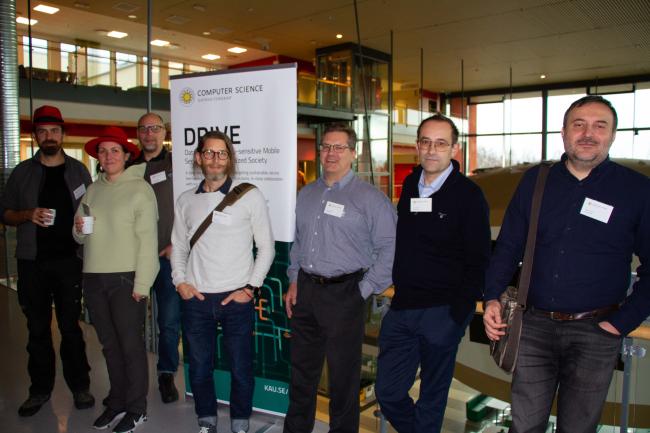Sweden (Karlstad University) Drive Kick-Off – Starting Point For Latency Research

On November 16-17, the DRIVE project held a two-day kick-off meeting at Karlstad University. The aim for the kick-off was to get the DRIVE and its subprojects officially started and to let all partner representatives and researchers meet face-to-face.
– I am very excited to get started! A project of this great distinction and societal importance strengthens our research environment even more and puts Karlstad University on the map, says Professor Anna Brunström, project manager of DRIVE. I have high expectations for everything DRIVE can provide.
The assembly was welcomed by Professor Stefan Lindskog, dean of the Faculty of Health, Science and Technology at Karlstad University. Professor Anna Brunström followed, introducing the DRIVE project and its scope, as well as the programme for the kick-off meeting.
The DRIVE project (Data-driven latency-sensitive mobile services for a digitalised society) looks at how latency-sensitive mobile services can be designed in the most optimized, secure and energy-efficient way. The project is funded by the Knowledge Foundation and will run for a period of eight years.
Progress within this field of research is important for many functions in society, such as autonomous driving, autonomous manufacturing, smart grids and remote surgery.
DRIVE is based on a close collaboration between Karlstad University and 7 partner companies: Ericsson, Telia, Icomera, Mullvad, Varnish Software, TietoEvry and Red Hat. The partner companies contribute with complementary expertise and perspectives. During the kick-off, all partner companies had the chance to meet and network with the researchers at Karlstad University as well as with each other.
The DRIVE project is divided into 4 subprojects.
Subproject 1, Programmable and secure connectivity, is lead by Professor Andreas Kassler. Networks need to become more flexible, more performant, as well as more energy efficient, but how?
The objective of the research is to use network programmability to flexibly accelerate mobile networks and services, including traffic analysis defenses, while supporting a diverse set of programmable targets. And the easy to grasp research question is: How to achieve performance of hardware while at same time be programmable and flexible?
Subproject 2, Data-driven Network Service Optimization, is lead by senior lecturer Karl-Johan Grinnemo. Its main objective is to design data- and service-driven solutions for adaptive and efficient communication.
Progress within this field of research would help public and private mobile networks throughout society to function more smoothly, in terms of configuration as well as available services and optimized access to the networks.
Among the research questions are what features to expose in a mobile network, how to optimize traffic over several network paths and how to protect against network inferences?
Subproject 3, Service Optimization in Federated Edge Platforms, is lead by Professor Javid Taheri.
Edge computing is the next generation of computing platforms to bring computing to where the data is created or where the processing is required. Edge computing is one of the drivers for future industries and a fundamental component in 5G networks.
Considering its unique characteristics to cover a wide range of possible applications to society, for instance within Remote AI Assistance/Support in Vehicular Networks or Industry 4.0, multiple edge providers are expected to enter the market. This requires optimizing many parameters in such multi-owned platforms so that all providers satisfy their customers.
Subproject 3 aims to use AI/ML-based approaches to optimize management and orchestration of edge services in federated edge computing platforms.
Subproject 4, Testbeds and Benchmarking Measurement,is lead by senior lecturer Johan Garcia.
Measurements in both commercial and testbed environments are important to understand the evolution of 5G/6G network performance over time and space, to validate the solutions developed in other DRIVE subprojects, and to identify performance bottlenecks.
Subproject 4 provides and manages experimental infrastructure, i.e. testbeds, large-scale measurements processing and analysis platforms, and considers performance from the view point of a network user/secondary service provider. For this, one important infrastructure is the 5G testbed at Karlstad University.
The main objective for subproject 4 is to provide the needed experimental infrastructure and to measure and analyze performance aspects in cellular networks from an end-user perspective. Research questions to be studied include what are the traffic characteristics and application performance in 5G/6G mobile networks and how can available network metrics be exploited to model and better understand the factors that influence performance.
During the coffee and lunch breaks, one could take part in a poster session where ongoing PhD projects connected to DRIVE were presented. Among those, one could learn more about subjects such as improvements of device battery life, how to monitor latency or an architecture for network slicing.
– We had a lot of interesting and fruitful discussions during these two days, and we are looking forward to the knowledge transfer to come between industry and academia, says Professor Anna Brunström.
